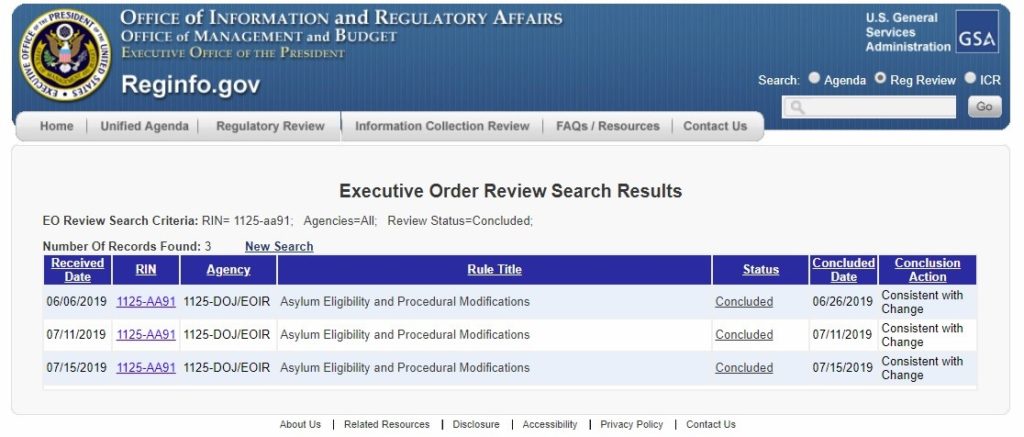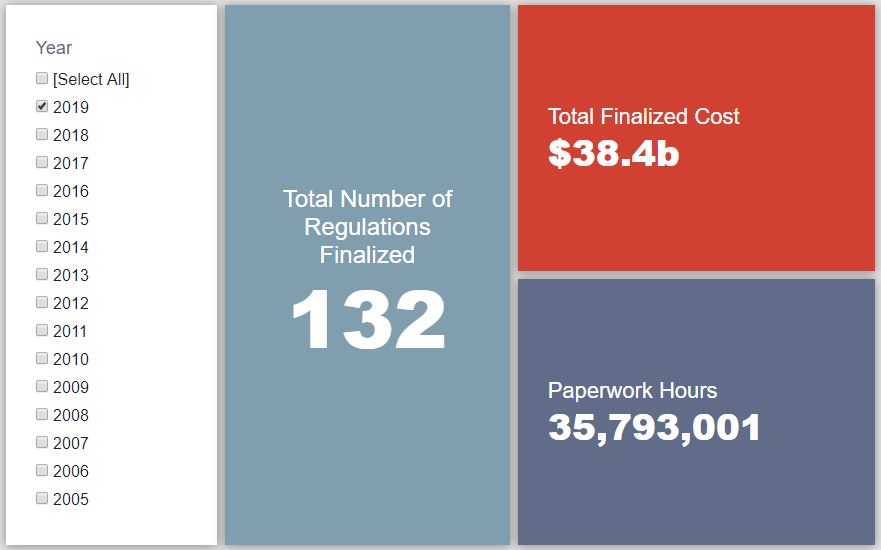Week in Regulation
July 22, 2019
A Health Care-Heavy Week
This past week, there were eight rulemakings published in the Federal Register that had some quantified cost or paperwork estimate. Of those eight, four came from the Department of Health and Humans Services (HHS). The most consequential of the bunch was actually a deregulatory measure. Across all proposed and final rules, agencies published $2.9 billion in total net cost savings but added 109,924 hours of paperwork.
REGULATORY TOPLINES
- New Proposed Rules: 40
- New Final Rules: 58
- 2019 Total Pages: 34,934
- 2019 Final Rule Costs: $38.4 Billion
- 2019 Proposed Rule Costs: -$1.2 Billion
TRACKING THE REGULATORY BUDGET
The most significant rulemaking of the week was a proposed rule out of HHS regarding “Medicare and Medicaid Programs; Requirements for Long-Term Care Facilities: Regulatory Provisions To Promote Efficiency, and Transparency.” The proposal seeks to remove “unnecessary, obsolete, or excessively burdensome” aspects of the long-term care program. HHS expects such reforms to yield $616 million in savings “over each of the first 5 years” – roughly $3.1 billion overall. Since this is still a proposed rule, however, these savings do not accrue to the fiscal year (FY) 2019 regulatory budget under Executive Order (EO) 13,771.
So far in FY 2019 (which began on October 1, 2018), there have been 53 deregulatory actions (per the rubric created by EO 13,771 and the administration’s subsequent guidance document) against 29 rules that increase costs and fall under the EO’s reach. Combined, these actions yield quantified net costs of roughly $11.4 billion. This total, however, includes the caveat regarding the baseline in the Department of Agriculture’s “National Bioengineered Food Disclosure Standard.” If one considers that rule to be deregulatory, the administration-wide net total is approximately $4.7 billion in net costs. The administration’s cumulative savings goal for FY 2019 is approximately $18 billion.
THIS WEEK’S REGULATORY PICTURE
This week, notable regulatory activity — and inactivity —from the U.S. Citizenship and Immigration Services (USCIS).

It is no secret that one of President Trump’s core campaign issues included substantially altering America’s immigration system. Since there has been no major activity from Congress, the Trump Administration has sought to make changes through the legally more-perilous regulatory process.
The agency at the forefront of many of these rules is USCIS. This week the agency advanced two important rules, while news on a third has gone quiet.
On July 16, USCIS, along with the Department of Justice, issued an interim final rule (IFR) on asylum eligibility. This controversial rule requires individuals that have traveled through a “safe country” to apply for asylum in that country before attempting to apply in the United States. Since Mexico is a safe country, the effect of this rule is to block immigrants from Central America traveling by land to the United States from applying for asylum unless Mexico denies them first.

The rule moved through the regulatory process very quickly as it did not appear in May’s Unified Agenda, the document where federal agencies publish a list of rules on which they are working. It also had an interesting route (see image below) through the Office of Information and Regulatory Affairs (OIRA), the office at the Office of Management and Budget that reviews regulations. Undergoing three separate reviews in a three weeks is rare, if not unprecedented — though the quick review times could be because the agencies claim the rule was not subject to formalized review as it “implicates a foreign affairs function of the United States related to ongoing discussions with potential impact on a set of specified international relationships.”
Because the rule was issued as an IFR, it was not made available for public comment before its publication. The public has until August 15 to comment on the language, which the agencies will consider as it makes a permanent final rule. The IFR, however, has immediate effect and is already subject to legal challenges.
The USCIS advanced another notable rule this week, sending a draft version of its final Inadmissability on Public Charge Grounds rule to OIRA for review. This rule would expand the criteria under which officials can deny admittance to public charges, or individuals that officials believe will become primarily dependent on the government for subsistence.
Finally, there is the notable inactivity on a final rule to revise the EB-5 visa program. This program provides visas for individuals who make a major investment in a commercial enterprise in the United States and plan to create at least 10 permanent full-time jobs for American workers. Critics have argued the program is rife with abuse, and a proposed rule sought to reform the program. The final rule was cleared by OIRA on June 27, according to OIRA’s regulatory review website, but it has yet to appear in the Federal Register. The publication lag is considerable for a rule expected to only be about 30-50 pages in length, and no public reason has been given for the delay.
TOTAL BURDENS
Since January 1, the federal government has published $37.2 billion in net costs (with $38.4 billion in finalized costs) and 38.9 million hours of net paperwork burden increases (with 35.8 million coming from final rules). Click here for the latest Reg Rodeo findings.












